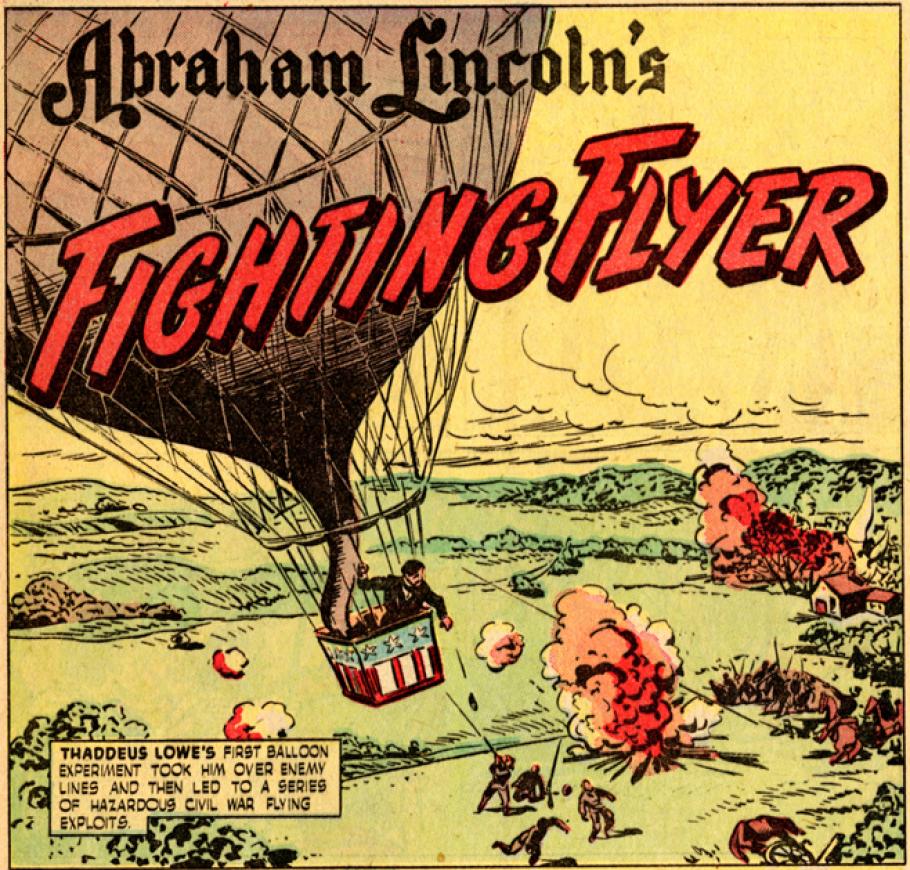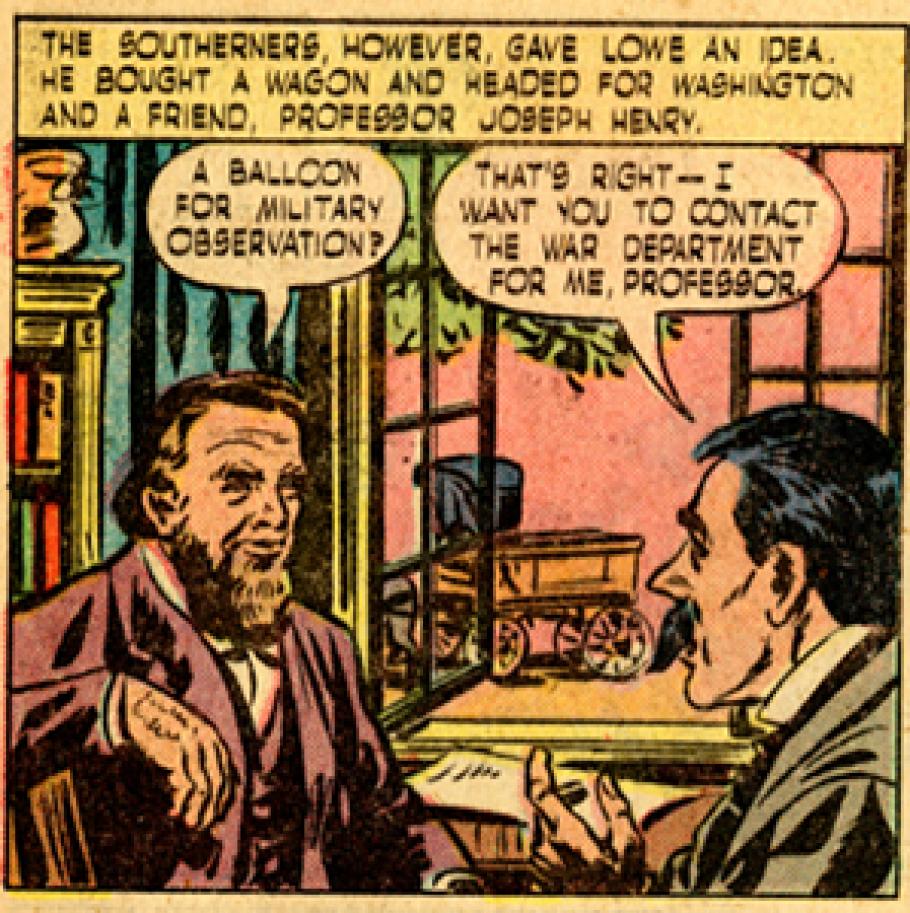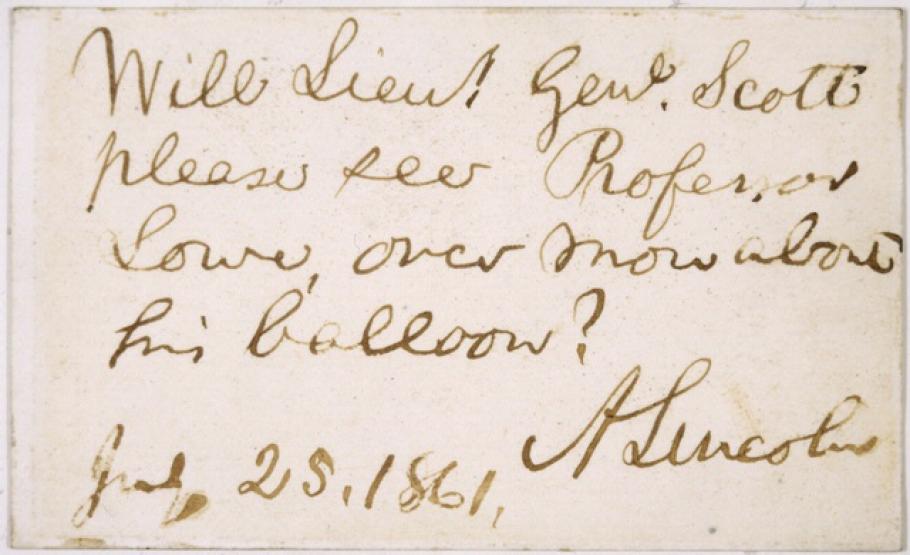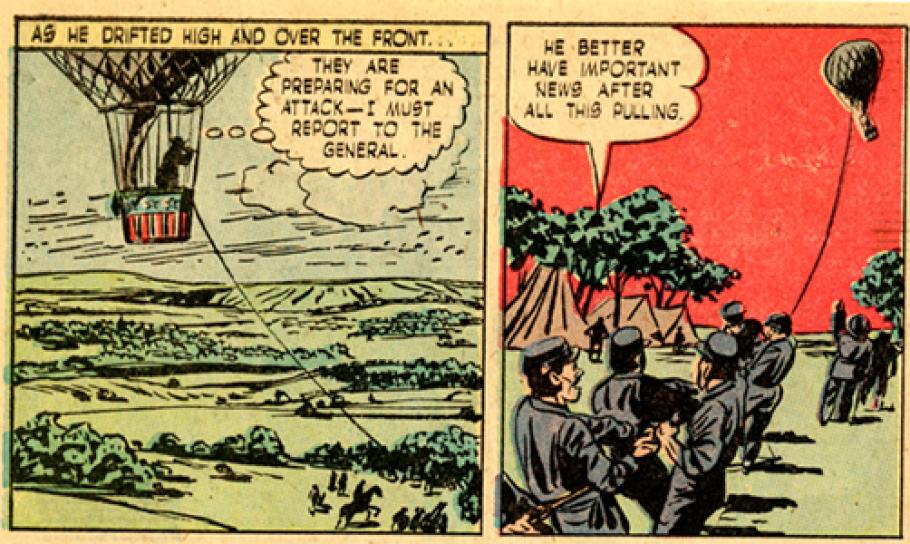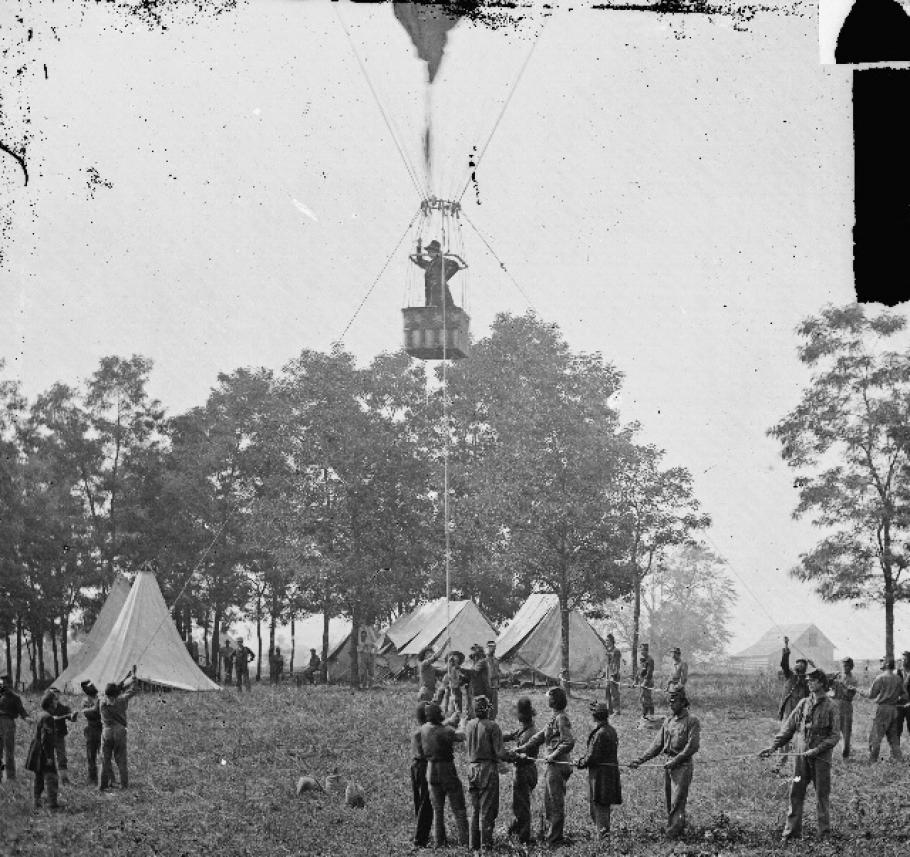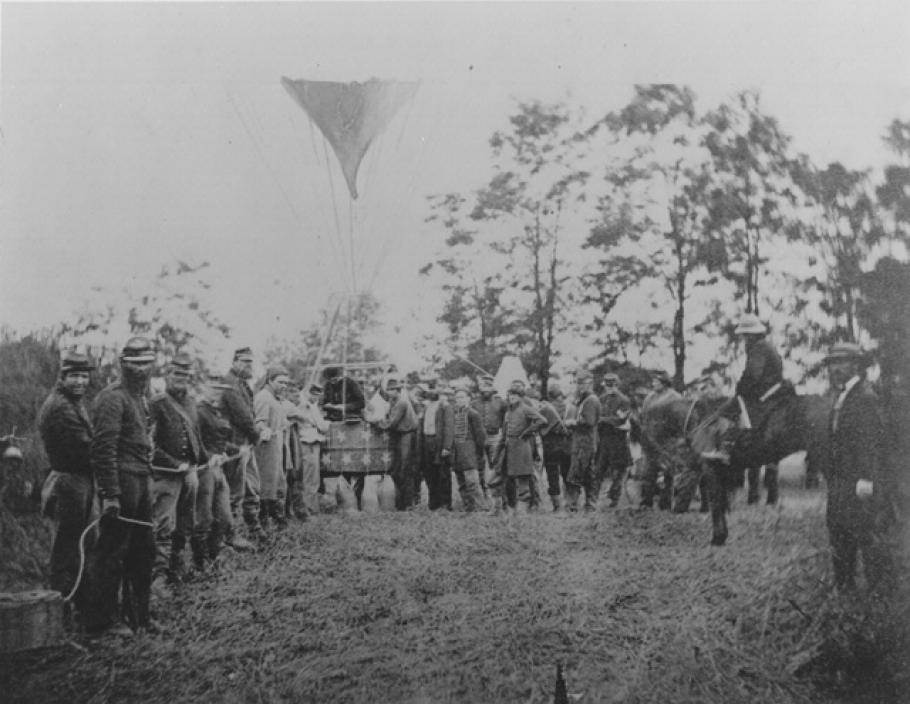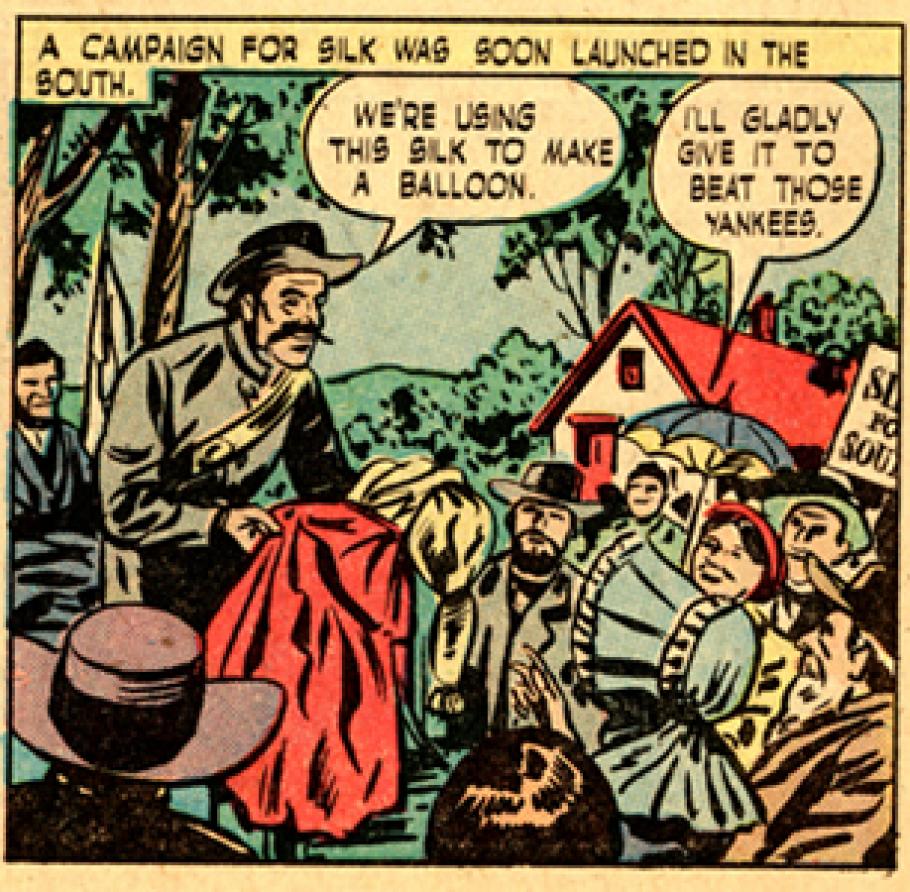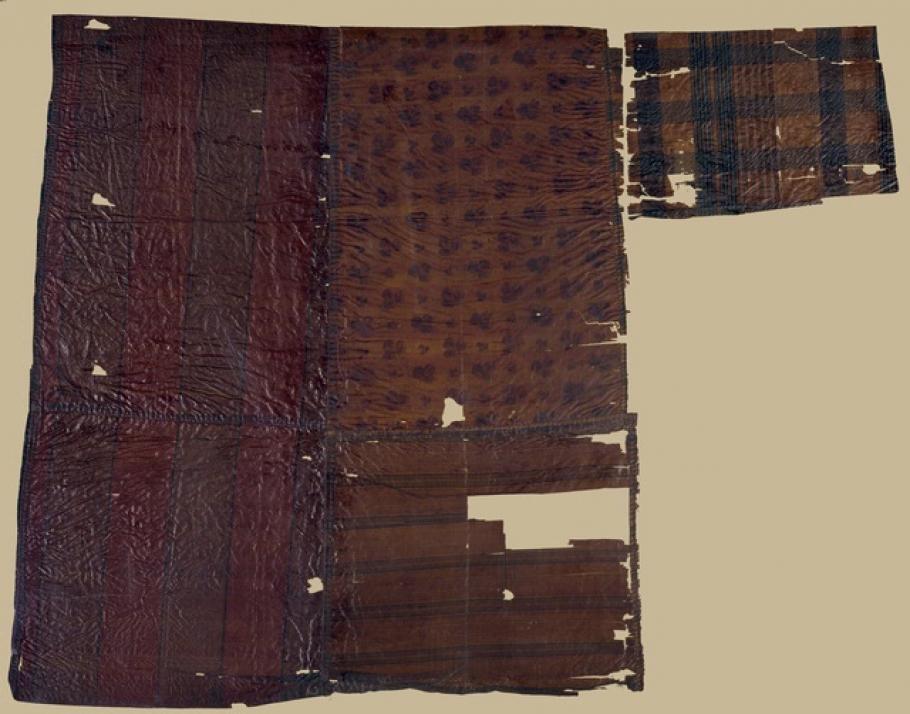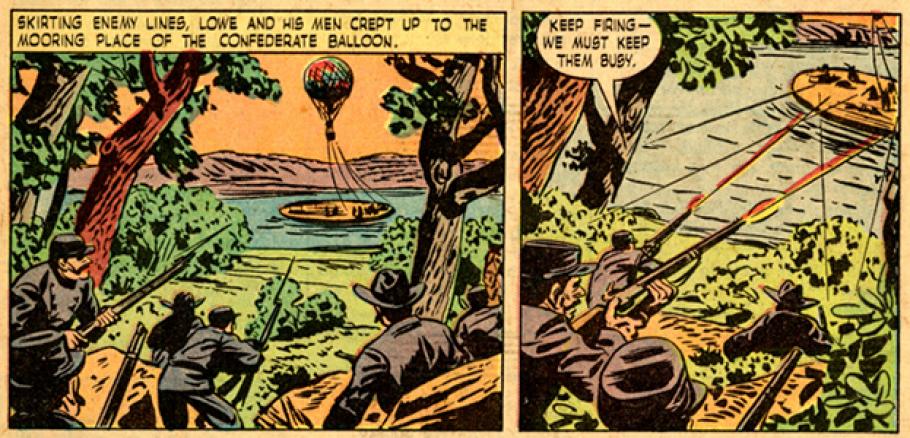For many people, sitting down and reading a thick history book is not the most exciting proposal. I have had more than one relative question my choice to study history, and inform me that it was their least enjoyable class in school. Luckily for them, history can be found in more places than traditional scholarly textbooks. History can be found in television, movies, and even comic books. Although it may be more enjoyable to experience history in this way, these sources may not always be the most accurate representations.
First panel of Lincoln Flying Fighter comic strip depiting Thaddeus Lowe's balloon in combat.
During World War II, a series of comic books began publication known as “True Comics.” The comics described stories featuring “real people” and “world-shaking history,” especially focusing on recent events of World War II. In issue 70, a story entitled “Abraham Lincoln’s Fighting Flyer” was written detailing Thaddeus S.C. Lowe and the actions of the Union Army’s balloon corps. Although the comic did contain truthful details about Civil War balloons, it did not get everything correct. Below are some examples of the portions the comic portrayed accurately, as well as those which were a little bit off the mark.
Comic Clipping 1: Did Thaddeus S.C. Lowe really meet with Professor Joseph Henry?
Panel depicting Joseph Henry speaking with Thaddeus Lowe in the comic strip Lincoln's Flying Fighter.
Answer: Yes! In this panel, aeronaut Thaddeus S.C. Lowe is shown meeting with American scientist Joseph Henry in Washington D.C. Henry, who was the first secretary of the Smithsonian Institution, met Lowe before the war and was interested in his experiments with ballooning. When the war broke out, Lowe had difficulties obtaining a meeting with the War Department. Henry, who was well known and respected in Washington, was able to help Lowe provide a demonstration and eventually get a meeting. In fact, Lowe demonstrated the ascension of his balloon in Washington D.C. near the Smithsonian Castle.
Comic Clipping 2: Did Abraham Lincoln give approval for the Balloon Corps?
Panel of Lincoln Flying Fighter comic strip depiting Thaddeus Lowe speaking with President Lincoln.
Answer: Yes! In this panel, Abraham Lincoln is seen using his powers as Commander in Chief to push for the incorporation of Lowe and his balloons into the Union Army. The balloon demonstration Lowe made from what is today the National Mall provided Lincoln with evidence that balloons could serve a military purpose. After the successful demonstration, Lincoln wrote a note to his reluctant top general, Winfield Scott, urging him to give Thaddeus Lowe and his balloons a chance to demonstrate their usefulness.
Comic Clipping 3: Were Thaddeus Lowe’s balloons controlled by Union soldiers with ropes?
Union soldiers hold a balloon by rope in this comic strip called Lincoln's Flying Fighter.
Answer: Yes! In this panel, Thaddeus S.C. Lowe can be seen in his balloon making observations of enemy troop locations. In order to keep the balloons stationary and prevent them from drifting into enemy territory, all of Lowe’s balloons were tethered to the ground and were raised or lowered by Union troops. These troops were specifically attached to the Balloon Corps in order to assist with filling the balloons with gas, as well as manually control the balloons. It was physically demanding work, but the soldiers performed the task very well.
Comic Clipping 4: Did Thaddeus Lowe really drop bombs on enemy troops?
Thaddeus Lowe throws hand grenades from a balloon in this comic strip called Lincoln's Flying Fighter.
Answer: No! Not at all! In this panel, Thaddeus Lowe is shown drifting over the enemy and pummeling them with hand-dropped bombs. This certainly adds drama to the story, but it is not accurate at all. The balloons of the Union Balloon Corps were often kept behind Union lines where they could be protected, and did not drift over Confederate lines on bombing missions. The balloons were always launched with tethers attached, and they were used to observe troops movements, troop locations, and to make maps. The balloons were often fired upon when they rose for observation flights, and it would not have been safe to let them drift over enemy territory.
Comic Clipping 5: Did Confederate officials really collect silk dresses in order to make their own balloons?
Comic strip depicting Confederate soldier collection women's silk dresses to use in creating a balloon from the comic strip Lincoln's Flying Fighter.
Answer: No, this is just a myth. In this panel, a Confederate officer is shown collecting silk dresses from women of the South so that Confederate forces could build a balloon of their own. As I explained in a previous blog post, this is a myth which was perpetuated after the war. In reality, new bolts of dress silk were purchased in Georgia and South Carolina, and were cut up and sewn together to form a patchwork balloon. This balloon, officially named Gazelle, was often referred to as the “Silk Dress” balloon because of its appearance. It was used by Confederate forces in Virginia during the Peninsula Campaign in 1862. No actual dresses, however, were harmed in its construction.
Comic Clipping 6: Did Union soldiers capture the Confederate balloon after a daring raid on a balloon barge?
Union soldiers attacking Confederate balloon barge in comic strip Lincoln's Flying Fighter.
Answer: Well, not exactly. In this panel, Union soldiers are shown sneaking up to the Confederate balloon barge and engaging it in order to stop the Confederate balloon from viewing the Union army. In reality, the Confederate “silk dress” balloon was captured by the Union Navy. On July 4, 1862, the USS Maratanza located and engaged the CSS Teaser on the James River. The CSS Teaser was a small armed Confederate tug used to transport the Confederate balloon along the James River between Richmond and the battlefields of the Virginia Peninsula. After a brief battle, the CSS Teaser was disabled and captured by the Union Navy. While inspecting the ship, Union sailors discovered the Confederate balloon stored on board. It was given to Thaddeus S.C. Lowe, but he decided it was of no use and cut it up into small scraps as souvenirs.
Although “Abraham Lincoln’s Fighting Flyer” is not 100% historically accurate, it does provide a brief glimpse into a very interesting portion of American aviation history. It is certainly a riveting and accessible story to read. If you want to read the entire comic, it can be found here starting on page 39. If it spurs your interest in Civil War aviation, I suggest you dive into a more accurate source, such as the Museum’s website on Civil War ballooning or the online conference entitled “Mr. Lincoln’s Air Force.” And who knows, one day you may find yourself reading and enjoying a nice, thick history book on the subject.

